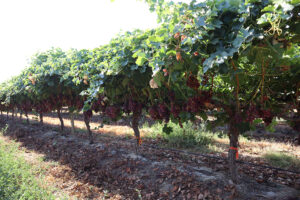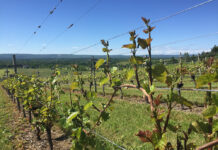
Red table grape appeal lies in uniform berry color and a crunchy, crisp texture.
Managing the crop to achieve color and firmness at harvest and preserve those qualities in cold storage requires recognition of the many factors that can affect berry color and firmness.

At the Southern San Joaquin Valley Grape Symposium, UCCE Kern County Viticulture Advisor Tian Tian said variety difference, harvest timing, environmental conditions, vineyard management and weather are all factors that can influence berry firmness. Trials conducted to date have been inconclusive in finding which products work best for firmness, color and brix.
Tian said in a variety named Krissy, berries begin losing firmness at the onset of veraison and their firmness decreases during ripening. This softening is due to degradation of pectin and cellulose in the cell wall, reduction in intercellular adhesion and loss of turgor pressure with increased concentrations of fructose and glucose in the berry apoplast, the extracellular space outside of plant cell membranes.
Berry color develops as anthocyanins accumulate in berry skin. High temperatures slow down anthocyanin synthesis and accelerate its degradation.
Role of Nutrition and Other Practices
Tian said foliar-applied nutrition plays a part in berry quality, strengthening cell walls and reducing heat damage. Even a small portion of calcium and magnesium in a foliar spray is allocated to the fruit, and increase in calcium in the fruit may lead to pectin degradation and strengthen the cell-to-cell adhesion, improving fruit firmness. A foliar orthosilicic acid spray may increase cross-link between polysaccharides and reinforce cellulose fibers. It may also reduce cell wall destabilization under high temperature.
Crop load adjustment is a management practice that allow vine resources to go to remaining clusters after thinning. Leafing at veraison is another management practice that can promote better light penetration in the canopy. While light is essential to trigger anthocyanin accumulation in some varieties, it can also lead to sunburn. Tian said a 2022 study of leaf removal did not show any improvement in berry coloration.

Tian’s data presented at the symposium showed findings by the first harvest. She was not able to complete the trial due to the summer storm. She also noted that the experimental block had a lower-than-normal crop load. The trial will continue this year.
Possible solutions for pre-harvest fruit softening in red table grape varieties include early harvest or slowing down the decrease in berry firmness during fruit ripening to minimize the risk of pre-harvest fruit softening.
Ashraf El-Kereamy, UC Riverside and UC Lindcove, said the use of ethylene-releasing compounds to improve red color in grapes needs more attention due to increased global temperatures.
Understanding Growth Cycle
Understanding grape berry growth cycle can help with promoting color. The first stage is the formation cycle where berry formation starts with cell division in pericarp tissue and flower starts to transform into fruit. Water transfers into berries via xylem and phloem to enlarge berries. The berry is green and hard. The second stage is the ripening cycle. Sugar accumulations, phenolics and flavor compounds begin. Color changes from green.
Formation of each compound is temperature- and light-dependent, but the ripeness of the berry is determined by sugar level and color.
In research funded by the California Table Grape Commission, published in Frontiers in Plant Science, El-Kereamy notes red color results from anthocyanin pigment. The anthocyanin pathway is regulated by light and antioxidant activity, among other factors. Even with cultural practices, he said it is still challenging to produce table grapes with high coloration.
Five plant hormones play a role in grape berry development: auxin, cytokinin and gibberellins, which are active in early development, and abscisic acid and ethylene, which are active at onset of ripening. These ripening hormones need to be kept in balance, El-Kereamy said, and work together to produce color.
In El-Kereamy’s research, treatments included ethephon (ET) at 600 mg/L, silicon at 175 mg/L and a commercial light-reflective white ground cover (RGC) alone and in various combinations. Treatments were conducted either with or without a combination of cluster-zone leaf removal at veraison (LR) on Flame seedless grapes.
The treatment was carried out at veraison when 30% of berries in the clusters were turned red, and maximum red grape coloration was observed when combining ethephon with the ground white plastic cover and Si due to enhancing both anthocyanin biosynthesis and antioxidant enzyme activity. Using the light-reflective white ground cover did not restrict the water supply as the water was freely reaching the vine rootzone. LR at this stage increased berry temperature that might reduce the effectiveness of ethephon on berry coloration.
Data collected in 2019 and 2020 in El-Kereamy research showed the best treatment to improve berry coloration was using ET in combination with Si and RGC, applied at veraison. Adding LR to this combination did not improve berry color any further but rather caused a reduction in color development. Use of reflective ground cover without LR at veraison significantly increased the quantity of reflected blue and red lights as well as the red to far-red ratio around clusters.
Manipulating the light spectrum and application of Si in combination with the ethephon treatment could be used in table grape vineyards to improve the ethylene-induced anthocyanin accumulation and coloration, he noted in his research.
The control and LR had the least effect on color. LR, El-Kereamy noted,can have harmful effects in high-heat situations and may reduce the effectiveness of ethephon on berry coloration.
Take-away message is excessive stress can impair anthocyanin biosynthesis and accumulation in the berries. Other hormones can positively or negatively affect the vine’s response to ethylene. Using appropriate cultural practices to allow ethylene to properly release will prevent triggering other promoter hormones.
El-Kereamy’s study showed the importance of light quantity and quality on ethylene-induced anthocyanin accumulation in red table grapes and its coloration. Manipulating light conditions surrounding the vines using RGC in addition Si enhanced the effect of ethephon.






